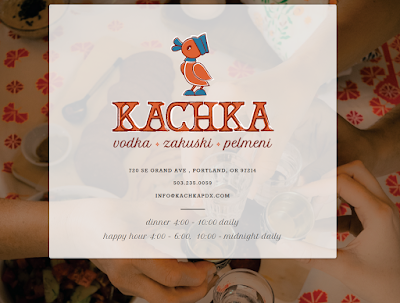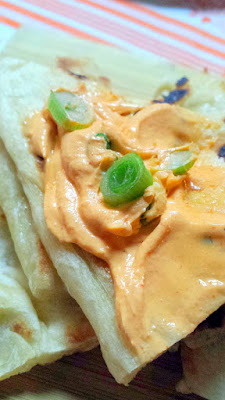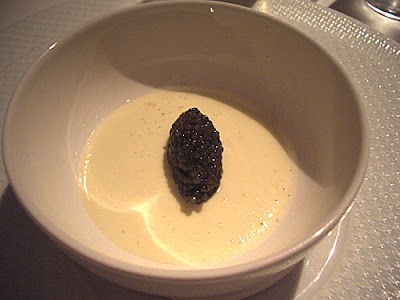Russian food is comforting and filling as you would expect from a country where it can get negative 30 below. For a country that has gone through so much famine and a generation with harsh memories of long queues for rationed food, what cuisine the people have been able to put together feels full of love and hope and celebration.
The cuisine has all the complexity yet simplicity of home-cooked, like you are at a family meal that has perfected and passed a recipe on through generations. The food feels emotional, with its contrast of plenty (though you will notice plenty of food showcasing mayo or pickles, or lots of flavors that may have been a way to make up for the small amount of meat since part of what you purchased may be rotten) with the reality of the harsh, melancholy heartbreak and hardship of Russian history.
One of my favorite restaurants when I lived in Chicago was Russian Tea Time (chef Bonnie Morales and husband Israel Morales are from Chicago too). When I moved from Chicago to Portland in 2008 I was disappointed by the lack of Russian cuisine in Portland. Then, after a few years I was thrilled when I got a bit of a taste with a Russian Pop-up at an early test of what would be eventually Da Net via Vitaly Paley’s Russian Pop-up back in March of 2013. Then, a month later, Kachka PDX opened as a permanent location to get a Russian cuisine fix . After completing a promise to myself to finish a book on Soviet food, I rewarded myself with several visits that I am now sharing with you. While DaNet, as I covered in a previous post, is a pop up Russian Experience with a set menu, Kachka is a restaurant you can visit any day and order your Russian meal a la carte.
Located at 720 SE Grand Avenue, Kachka doesn’t look like much from the outside with it’s rectangular, narrow long space that is dimly lit. Half the wall has fake windows, making you feel just like you were in a communal dining room with other comrades (well hello, I guess we are).
Stepping inside, you feel a bit like you are in a Russian living room with the utensils and napkins on the table in a flowery mug. , The tables are a bit cramped together to continue to give the requisite vibe of a communal space while thankfully, still having your own private table (no shared tables here unlike some actual communal table restaurants). A few kitschy references to Rodina (Russia portrayed as a Motherland) are scattered on the wall here or there to provide warmth, and there are a few pieces of Soviet political decor here or there as well.

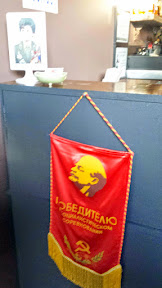
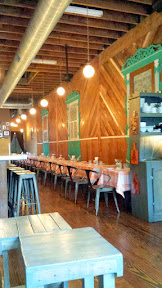


While my previous Russian restaurant experience offered more homey foods of the different regions of Mother Russia, Kachka focuses mainly on zakuski, which are small hot or cold super savory small plates that are meant to accompany enjoyment of vodka. The goal is to completely fill your table with zakuski and as you drink your vodka, always have a toast and a bite of zakuski along with spirited conversation.
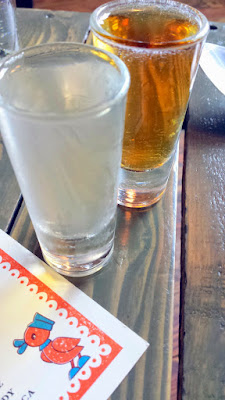
With their offering of a vodka flight at a reasonable 30 grams times three, or ordering any individual at sizes of 30, 60, or 100 grams, it’s possible to get a taste of that tradition of drinking and eating without going overboard. You can go traditional vodka or the infused with additional flavor liquors (mostly vodka but not exclusively) like lemon vodka, rosemary vodka, chamomile vodka, horseradish vodka, cocoa nib vodka and more like caraway rye whiskey or Earl Grey brandy. My personal favorite is the horseradish vodka.
They also have some pre organized vodka flights for you, this one is the Mother Russia vodka flight with from right to left, green mark, hammer + sickle, and imperia. Even if you don’t think you like vodka, I really encourage you to try one of the flavor vodka in 30 grams in the spirit of what Kachka is trying to do.
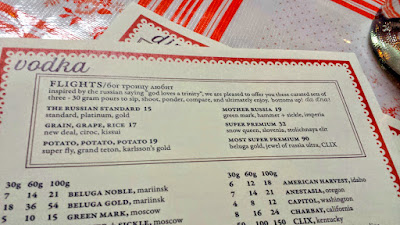
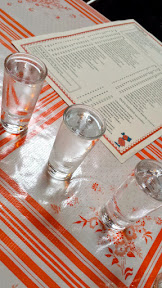


If you come at happy hour though, or you just want something a bit more with your vodka, check out the cocktails featuring some of those flavored liquors or vodkas. For instance, for a while there was the Baba Yaga with chamomile vodka, liquore strega, lemon. A constant cocktail offering (and also $5 at happy hour) is the Moscow Mule with vodka, lime, homemade ginger syrup, ginger beer. I will count that for you as trying Russian vodka too and getting into the spirit of zakuski.


Now let’s look at some of the drinking food, aka zakuski. The much raved about “Herring Under a Fur Coat” cold zakuski is beautiful, and it seems to be the glamour shot that represents Kachka in most media avenues that I see Kachka mentioned in.
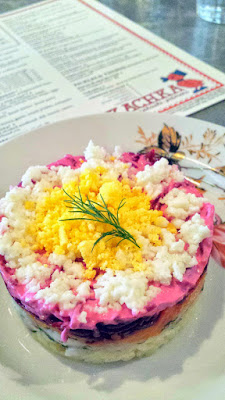

I did love the dish, but I also highly enjoyed different mayo Russian salad, perhaps even more so then the Herring Under a Fur Coat. That mayo Russian salad I’m referring to is the Duck Olivier. This cold zakuski is a take on salat Oliver, a traditional Russian salad that as I learned from reading Mastering the Art of Soviet Cooking (you can read my review of that book here), has lots of variations representing regions and even the type of person you are (privileged, peasant, artsy dissident…) in Russia. This is the most popular salad in Russia.
This cold salad includes diced boiled potatoes, carrots, brined dill pickles, green peas, eggs, celeriac, onions, diced boiled meat – in this case duck, and all mixed with mayonnaise. Kachka’s version uses duck meat and crispy duck skin, and duck fat mayo. Um, yummm. Fantastic. This is the salat Olivier that is my gold standard to beat and measure all salat Olivier or any potato salad.
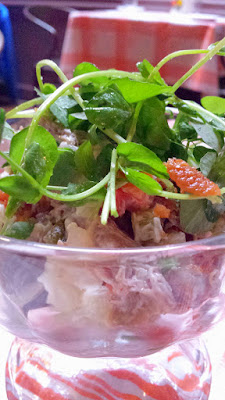
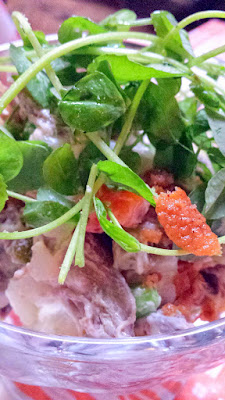
The lesson with either of those Russian salads, whichever one you try, is don’t be afraid of the presence of mayo. As I was enjoying these two dishes (2 different visits), I thought about the book I read, and how containers were hard to find during the Soviet era, and so mayo jars were very commonly used to hold anything and everything. Mayonnaise, similar to sour cream, dill, stews and oven baked pies, are a critical part of Russian food.
For a simpler cold zakuski that is vegetarian, try the brindza pashtet, a sheep cheese and paprika spread with scallion served with lavash.
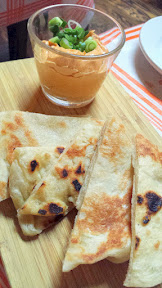
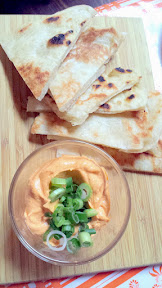

Or feel luxurious and fancy with one of the Caviar & Roe dishes – the most affordable one is the House Cured Steelhead, but during my visit we went for the prettier Beet Cured Whitefish. All the Caviar & Roe dishes are served with yeasted blini, challah, chive, butter, and sieved egg to make your little piles of bite sized vehicles for the caviar. The Blini here are small and thin, lighter and almost approaching crepe compared to the more richer decadant pancake Blini of DaNet.
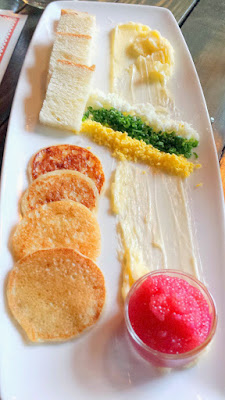

When it comes to hot zakuski, in particular the Horseradish Vodka pairs perfectly with this dish Crispy Beef Tongue with citrus marinated rhubarb, roasted garlic, chive blossom, and buckwheat cracker. Similar to the Herring Under a Fur Coat and the Duck Olivier, I think this Crispy Beef Tongue represents what Kachka is all about – the homey weirdness of some traditional Russian cuisine but elegantly and expertly refined to a fine dining level fit for a czar.
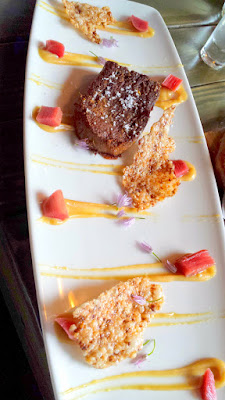

My favorite hot zakuski is the khachapuri, which is smoked sulguni cheese wrapped in dough, sort of like a pita quesadilla. It’s not as doughy or thickly cheesy comforting as an authentic Georgian khachapuri and the adjika is not nearly intense enough, but I can have this one with vodka anytime for dinner so I give points for accessibility and context for this take on the Georgian national dish. The more like a pita bread version here also has a slight crispness that is a great contrast to the oozy cheese, but be careful with your fingers as its less dough layers from that hot cheese to you too!


You should not miss the melt in your mouth dumplings – be it the meat ones like this Siberian Pelmeni with Beef, Pork, Veal and Onion or if you get the vegetarian version of Tvorog Vareniki with Farmers Cheese and Scallion. Do not miss this, it is a must order.
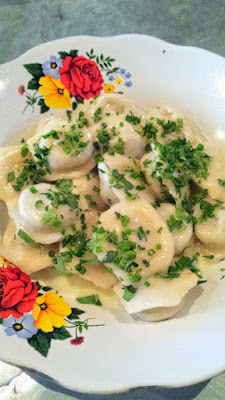
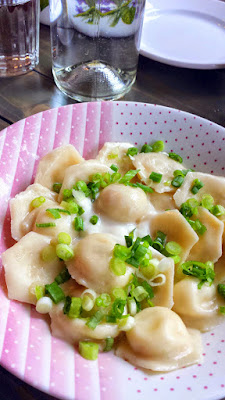
There are only a handful of main dishes, which rotate in and out with new items. During the winter months, I was surprised to see a traditional dish called kulebyaka of multi-layered pie filled with black cod, red chard and crepes, served with creme eurette. This is a time consuming dish – even at Kachka it takes 30 minutes to prepare from when you order. And it’s huge- enough to feed 2-4. I was glad I had a chance to try it while it was on the menu (it was rotated out in the spring menu).


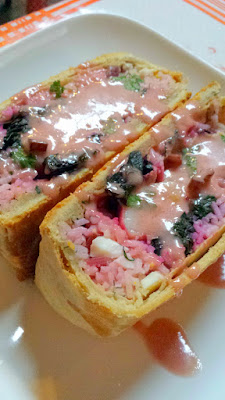
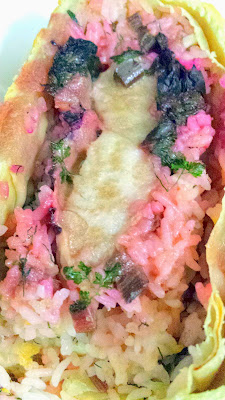
End your meal with some tea (or start with some if you come in on a cold windy rainy day like I did!). If you happen to come during happy hour, besides the pelmeni and vareniki dumplings which are both on the menu, there is also the option of the Red October with lamb meatballs, adjika, cheese all on a hoagie roll. It’s definitely the largest food item on the happy hour menu.

Because you can order a la carte Kachka gives you control of how many dishes you fill your table with, or simply order the zakuski experience and let the kitchen fill your table on your behalf. Zakuski plates are mostly small to encourage a lot of sharing and trying of a variety of dishes. As you can see everything is plated beautifully and elegantly rather than home style casual, which provides an atmosphere of luxury on the plate contrasting with the humble around you in the restaurant decor. It’s a feel of public communal dining hall but you are given individual party privacy and elevated take that made me feel a bit like a peek into the nomenklatura or privileged class of Russia. I can’t think of a better place in Portland to celebrate the art of zakuski in such an upscale way.
As a coincidence, I saw the day before this post was scheduled to be published that Eater just created a “One Night” feature on Kachka, which includes video and gorgeous photos giving you a peek at one night at Kachka – take a look at One Night at Kachka here. Eater’s feature piece does include pictures of every single thing on Kachka’s menu, at least in May, and a video on how they make those delectable dumplings. Also, it’s just a super cool feature that takes advantage of the web (I recommend seeing it on a computer as the design doesn’t translate as well to mobile though it’s still better than most any other article you would read online in embracing telling a story using all the media available).
What about you? Have you been to Kachka? Is there anything about Kachka that I’ve shared that makes you curious to give it a try? What did you think of the Eater feature if you perused it?







